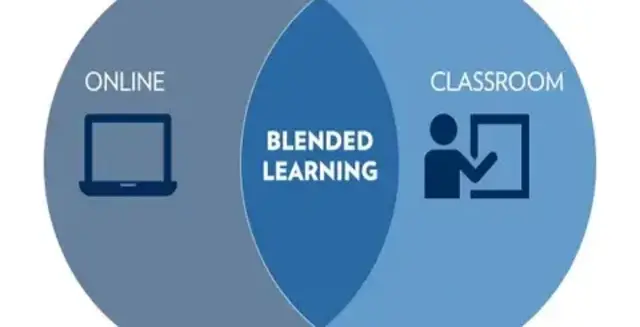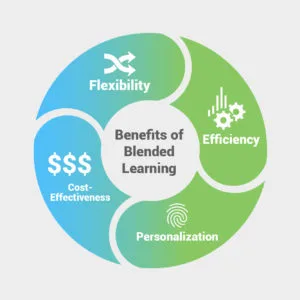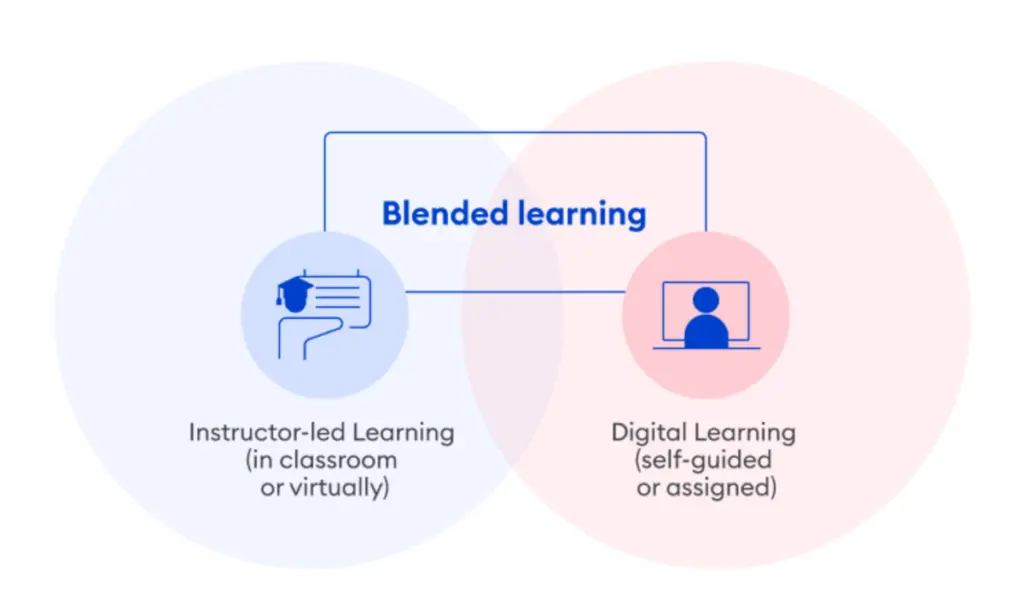
The introduction of technology has caused a great deal of change in education in recent years. One of the most notable developments is the emergence of blended e-learning, which is a technique that blends traditional in-person instruction with online learning. But what is blended e-learning, and how can educators effectively implement its various models? In this blog, we will discuss blended e-learning, its benefits, how the pandemic has affected its adoption, and in-depth information about its six main models.
What is Blended e-Learning?
Hybrid learning, often known as blended e-learning, is an educational strategy that combines online digital material with conventional classroom techniques. It gives students some autonomy over the location, schedule, course, and speed of their education. Because of its adaptability, blended learning is becoming a more and more popular option for K–12 and postsecondary educational environments.
A flipped classroom, in which students view lectures online and participate in practical exercises during class, is one kind of blended learning. Fully integrated courses, on the other hand, smoothly combine online and offline learning. Blended learning aims to create a more effective and interesting learning environment by combining the finest features of online and in-person training.
Advantages of Blended Learning

Personalized Learning
Customization of the learning process is one of the main advantages of blended learning. Pupils have the freedom to work at their speed, go over difficult content again, and utilize a range of educational tools. By addressing the various requirements and learning styles of each student, this customized approach makes sure that every student has the chance to achieve.
Increased Engagement
Multimedia and interactive materials are frequently used in blended learning, which can improve student engagement. A richer learning environment that may make difficult subjects more approachable and engaging is made possible by the mix of traditional and digital resources.
Flexibility and Convenience
More flexibility is provided by blended e-learning for both teachers and students. It is simpler for students to juggle their studies with other obligations because they have access to course materials at all times and locations. Teachers can also benefit from the flexibility, allowing them to manage their time more effectively and focus on providing personalized support.
Enhanced Collaboration
Better student-teacher and student-student collaboration is made possible by the incorporation of online tools. Virtual office hours, group projects, and online discussion boards are just a few instances of how blended learning can promote a more cooperative learning atmosphere.
Improved Outcomes
Studies have demonstrated that integrated learning can result in better academic performance. Through the integration of traditional and online learning approaches, students can enhance their comprehension and memory of the subject matter. Additionally, this method aids in the development of critical thinking, problem-solving, and digital literacy.
Blended Learning During the Pandemic
Worldwide, the usage of blended learning approaches has increased due to the COVID-19 pandemic. Teachers and educational institutions had to quickly adjust to new teaching approaches when remote learning suddenly became popular. A workable answer that provided a mix of online and offline training was blended learning.
Blended learning is a successful strategy for keeping the educational process going during the pandemic. It has made it possible for schools to provide high-quality instruction while enacting social distancing policies. The experience has also brought to light the necessity of strong online learning platforms and tools, as well as the significance of digital literacy for educators and students alike.
The 6 Models for Blended Learning

1. Face-to-Face Driver Model
With the help of online resources, the instructor teaches the majority of the curriculum in a conventional classroom setting under this paradigm. For educational institutions that wish to incorporate technology without significantly altering their current framework, this method is perfect.
2. Rotation Model
Students use the rotation model to move between several learning stations, such as independent study, small-group instruction, and online learning. Station rotation, lab rotation, flipped classroom, and individual rotation are further subcategories of this approach that offer varying levels of student autonomy and flexibility.
3. Flex Model
Under the flex model, teachers offer on-site help as needed, while the majority of the material is given online. This method works well for learners who can take advantage of the flexibility offered by online training and who feel at ease with self-directed learning.
4. Online Lab Model
Under the online lab paradigm, students study online in a traditional classroom environment. With this strategy, students can take classes that might not be offered at their school, giving them access to a wider variety of educational options.
5. Self-Blend Model
Under the self-blend model, students elect to supplement their traditional coursework with additional online courses. For determined students who wish to accelerate their studies or explore subjects outside of the regular curriculum, this model is perfect.
6. Enriched Virtual Model
The enriched virtual approach blends sporadic in-person encounters with online instruction. Although most of the coursework is done online, students do occasionally meet in person with their lecturers for guidance and assistance. This paradigm allows for a great deal of flexibility without sacrificing interpersonal communication.
Conclusion
In conclusion, blended e-learning offers a dynamic and flexible approach to education that combines the best of traditional and online instruction. By understanding what blended e-learning is and exploring its various models, educators can create a more personalized, engaging, and effective learning experience for their students. The advantages of blended learning, particularly highlighted during the pandemic, demonstrate its potential to transform education for the better. To learn more check What Is Student-Centered Learning and Why Is It Important?